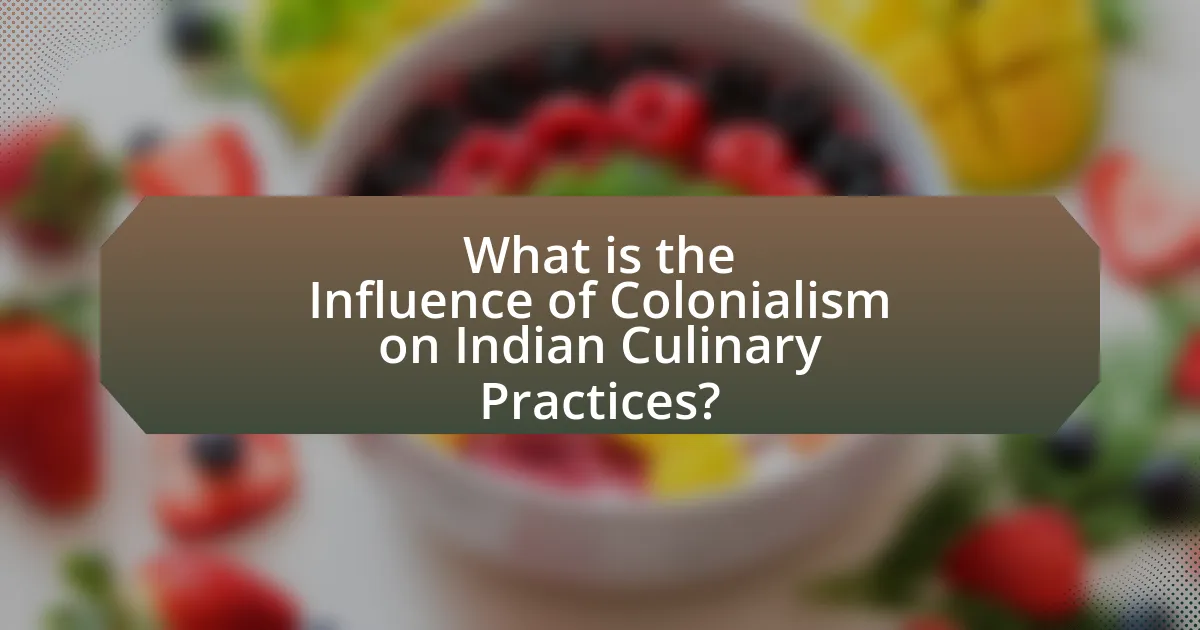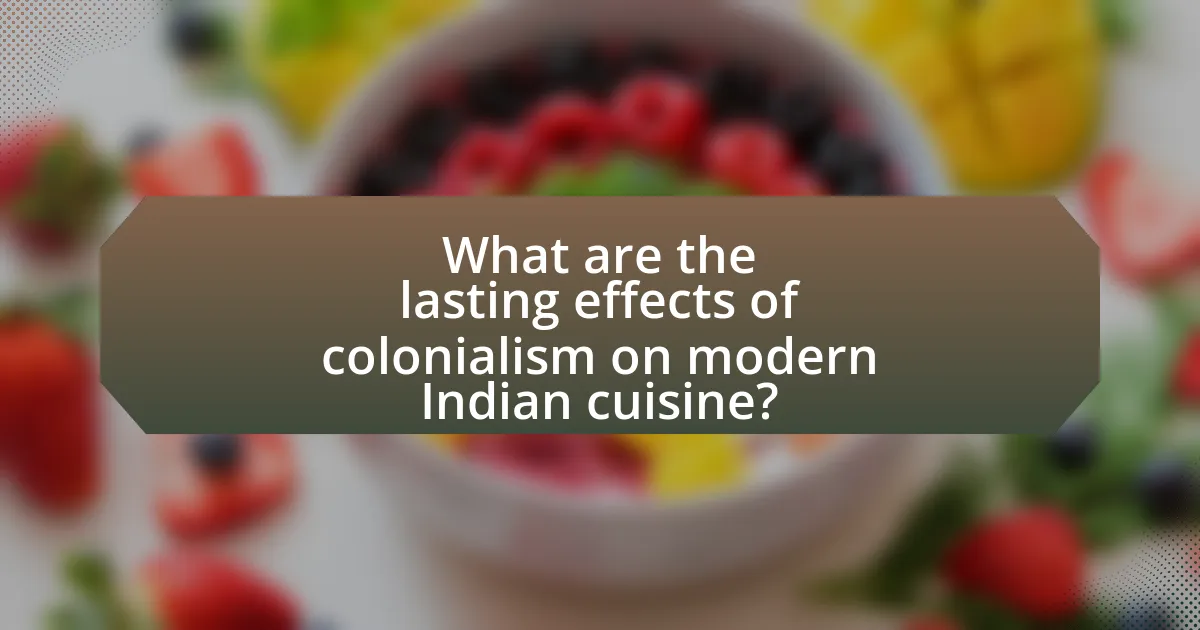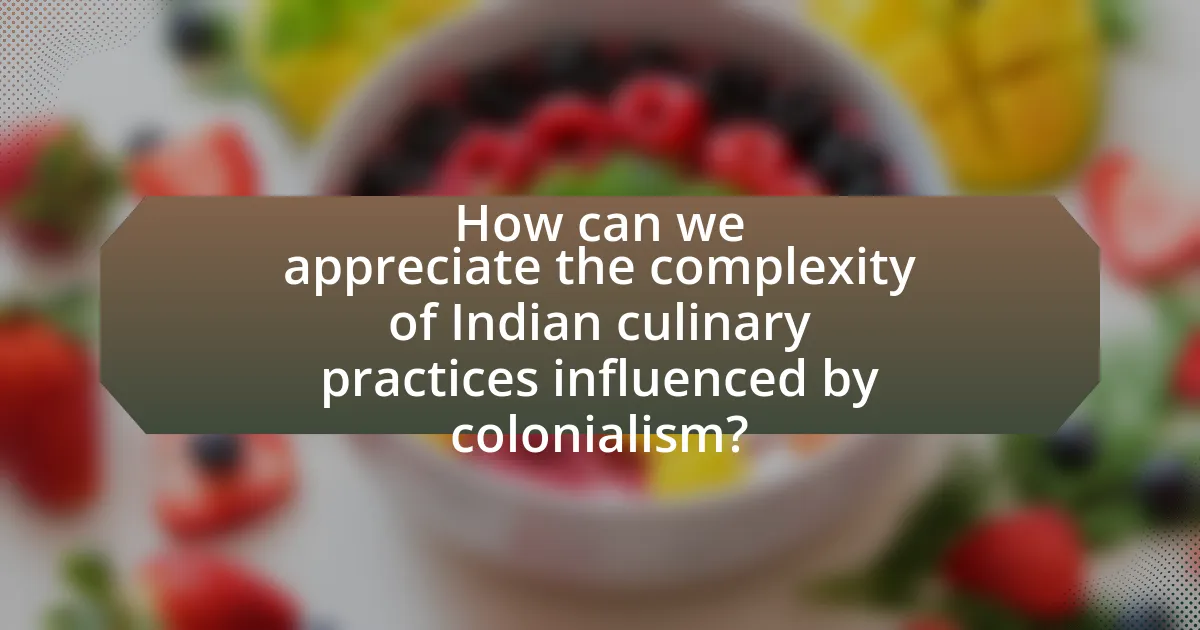The article examines the influence of colonialism on Indian culinary practices, highlighting how British colonial rule introduced new ingredients such as potatoes, tomatoes, and chilies, which became essential to Indian cuisine. It discusses the impact of colonial powers on food culture, including changes in cooking techniques, dining etiquette, and the fusion of Indian and Western culinary traditions. The article also explores the lasting effects of these influences on modern Indian cuisine, regional food diversity, and the social status associated with certain foods, while addressing common misconceptions about the colonial impact on Indian culinary identity.

What is the Influence of Colonialism on Indian Culinary Practices?
Colonialism significantly influenced Indian culinary practices by introducing new ingredients, cooking techniques, and food cultures. The British colonial period, particularly from the 18th to the 20th century, saw the introduction of items such as potatoes, tomatoes, and chilies, which became integral to Indian cuisine. Additionally, the British brought about changes in dining etiquette and meal structures, leading to the fusion of Indian and Western culinary traditions. For example, the concept of tea drinking was popularized, which integrated with local customs, resulting in the widespread popularity of chai. This blending of culinary practices illustrates how colonialism reshaped the Indian food landscape, creating a diverse and hybrid culinary identity.
How did colonial powers impact the food culture in India?
Colonial powers significantly altered the food culture in India by introducing new ingredients, cooking techniques, and culinary practices. The British colonial rule, for instance, led to the incorporation of foods such as potatoes, tomatoes, and chilies into Indian cuisine, which were previously unknown in the region. Additionally, the establishment of tea plantations transformed tea from a luxury item to a staple beverage in Indian households. The British also influenced dining customs, promoting the use of forks and knives, which contrasted with traditional Indian eating practices. These changes not only diversified Indian cuisine but also created a fusion of flavors and cooking styles that continue to shape contemporary Indian food culture.
What were the primary colonial influences on Indian ingredients?
The primary colonial influences on Indian ingredients were the introduction of new crops and spices by European powers, particularly the British, Portuguese, and Dutch. These colonial powers brought ingredients such as potatoes, tomatoes, and chilies from the Americas, which significantly altered Indian cuisine. For instance, the British facilitated the cultivation of tea in India, transforming it into a major agricultural product and cultural staple. Additionally, the Portuguese introduced ingredients like cashews and vinegar, which became integral to regional dishes. These exchanges not only diversified the Indian palate but also integrated global flavors into traditional cooking practices.
How did colonialism alter traditional cooking methods in India?
Colonialism significantly altered traditional cooking methods in India by introducing new ingredients, cooking techniques, and culinary practices. The British colonial period saw the introduction of foods such as potatoes, tomatoes, and chilies, which were not native to India and became integral to Indian cuisine. Additionally, colonial influences led to the adoption of Western cooking methods, such as baking and roasting, which contrasted with traditional Indian practices that primarily involved boiling, frying, and steaming. The establishment of railways and trade routes during colonial rule also facilitated the exchange of spices and ingredients, further diversifying Indian culinary practices. This blending of cultures resulted in hybrid dishes, such as the Anglo-Indian cuisine, which combined Indian flavors with British cooking styles.
What role did trade play in shaping Indian culinary practices during colonial times?
Trade significantly influenced Indian culinary practices during colonial times by introducing new ingredients and cooking techniques. The British colonial presence facilitated the exchange of spices, vegetables, and cooking methods between India and Europe, leading to the incorporation of foreign elements into traditional Indian cuisine. For instance, the introduction of potatoes, tomatoes, and chilies from the Americas transformed Indian dishes, making them more diverse. Additionally, the establishment of trade routes allowed for the spread of Indian spices to global markets, which in turn influenced local culinary practices in Europe and beyond, creating a reciprocal relationship that enriched both Indian and global cuisines.
Which new ingredients were introduced to Indian cuisine through colonial trade?
New ingredients introduced to Indian cuisine through colonial trade include potatoes, tomatoes, and chilies. These ingredients were brought to India by European traders and colonizers during the 16th and 17th centuries. Potatoes, originally from the Andes, became a staple in various Indian dishes, while tomatoes, native to western South America, transformed sauces and curries. Chilies, introduced from the Americas, significantly altered the spice profile of Indian cuisine, enhancing heat and flavor. The incorporation of these ingredients has had a lasting impact on the culinary landscape of India, showcasing the profound influence of colonial trade on local food practices.
How did the exchange of culinary techniques occur between colonizers and Indians?
The exchange of culinary techniques between colonizers and Indians occurred through trade, cultural interactions, and the adaptation of ingredients and cooking methods. Colonizers introduced new foods such as potatoes, tomatoes, and chilies, which were integrated into Indian cuisine, while Indians shared their spices and cooking techniques, influencing European culinary practices. Historical records indicate that the British Raj in India led to the fusion of British and Indian dishes, exemplified by the popularity of curry in British households. This mutual exchange resulted in a rich culinary landscape that reflects both colonial influence and indigenous traditions.

What are the lasting effects of colonialism on modern Indian cuisine?
Colonialism has significantly influenced modern Indian cuisine by introducing new ingredients, cooking techniques, and culinary practices. The British colonial period, in particular, led to the incorporation of foods such as potatoes, tomatoes, and chilies, which were previously unknown in India. These ingredients have since become staples in various regional dishes, showcasing the fusion of indigenous and colonial influences. Additionally, colonialism introduced the concept of dining etiquette and meal structuring, which altered traditional eating habits. The legacy of colonial rule is evident in the popularity of Anglo-Indian dishes, such as curry and bread, which reflect a blend of British and Indian culinary traditions. This historical context underscores the profound and lasting impact of colonialism on the evolution of Indian cuisine.
How have colonial influences persisted in contemporary Indian dishes?
Colonial influences have persisted in contemporary Indian dishes through the incorporation of ingredients, cooking techniques, and flavor profiles introduced during British rule. For example, the use of potatoes in dishes like aloo tikki and the popularity of tea, which became a staple beverage in India, are direct results of colonial influence. Additionally, the fusion of Indian spices with British culinary practices led to the creation of dishes such as curry, which has evolved into various forms, including the Anglo-Indian dish of chicken curry. The adaptation of Western baking techniques has also resulted in the popularity of pastries and cakes in Indian cuisine, showcasing a blend of traditional Indian flavors with colonial baking methods.
What are some examples of fusion dishes that emerged from colonial times?
Some examples of fusion dishes that emerged from colonial times include Chicken Tikka Masala, which combines Indian spices with British culinary techniques, and the Anglo-Indian dish Kedgeree, made from rice, smoked fish, and eggs, reflecting both Indian and British influences. These dishes illustrate the blending of culinary traditions during the British colonial period in India, where local ingredients and cooking methods were adapted to suit British tastes, leading to the creation of unique, hybrid cuisines.
How do modern Indian restaurants reflect colonial culinary influences?
Modern Indian restaurants reflect colonial culinary influences through the incorporation of British ingredients, cooking techniques, and dining customs. For instance, the use of ingredients like potatoes and tomatoes, which were introduced during colonial rule, has become integral to many Indian dishes. Additionally, the adaptation of cooking methods, such as baking and roasting, can be traced back to British culinary practices. Furthermore, the concept of a multi-course meal, often seen in modern Indian dining, mirrors the British tradition of formal dining, showcasing a blend of Indian and colonial influences in the culinary landscape.
What changes occurred in food consumption patterns due to colonialism?
Colonialism significantly altered food consumption patterns by introducing new ingredients, altering agricultural practices, and reshaping culinary traditions. The British colonial rule in India, for instance, led to the introduction of crops like potatoes, tomatoes, and chilies, which became staples in Indian cuisine. Additionally, colonial policies favored cash crops over subsistence farming, impacting local diets and food availability. Historical records indicate that the British also influenced dining customs, promoting the use of forks and knives, which changed traditional eating practices. These shifts in food consumption reflect broader economic and cultural transformations initiated by colonial powers.
How did colonialism affect the social status associated with certain foods?
Colonialism significantly altered the social status associated with certain foods by introducing new ingredients and culinary practices that reshaped local diets and perceptions. For instance, during British colonial rule in India, foods like potatoes and tomatoes, which were previously unfamiliar, became staples and were often associated with modernity and progress. This shift elevated the status of these foods among the local population, while traditional foods were sometimes viewed as less sophisticated. Additionally, colonial policies favored the production of cash crops, such as tea and coffee, which not only changed agricultural practices but also created a social hierarchy where these imported goods were seen as symbols of wealth and status. The British elite’s preference for these items further entrenched their social significance, leading to a lasting impact on culinary practices and food perceptions in India.
What impact did colonialism have on regional food diversity in India?
Colonialism significantly reduced regional food diversity in India by promoting monoculture and introducing foreign crops. The British colonial policies prioritized cash crops like cotton and indigo over traditional food crops, leading to a decline in local agricultural practices and a loss of indigenous varieties. For instance, the introduction of crops such as tea and coffee altered local diets and farming systems, diminishing the cultivation of diverse native grains and vegetables. Additionally, the focus on export-oriented agriculture during colonial rule marginalized local food systems, resulting in a homogenization of diets across regions. This shift not only impacted food availability but also eroded traditional culinary practices that relied on a rich variety of local ingredients.

How can we appreciate the complexity of Indian culinary practices influenced by colonialism?
To appreciate the complexity of Indian culinary practices influenced by colonialism, one must examine the fusion of indigenous ingredients and techniques with foreign culinary traditions introduced during colonial rule. This blending resulted in diverse regional cuisines that reflect both local heritage and colonial influences, such as the incorporation of European spices and cooking methods. Historical evidence shows that the British colonial presence in India led to the introduction of new food items, like potatoes and tomatoes, which transformed traditional dishes. Additionally, the establishment of the railway system facilitated the spread of regional cuisines across the subcontinent, further enriching the culinary landscape. Understanding these dynamics reveals how colonialism reshaped Indian food culture, creating a complex tapestry of flavors and practices that continue to evolve today.
What are some best practices for exploring colonial influences in Indian cooking?
To explore colonial influences in Indian cooking, one should analyze historical recipes and cooking techniques introduced during colonial rule. This includes examining the integration of ingredients such as potatoes, tomatoes, and chilies, which were brought to India by European traders and colonizers. Additionally, studying the adaptation of cooking methods, such as baking and roasting, which were influenced by British culinary practices, provides insight into the fusion of Indian and colonial cuisines. Researching cookbooks from the colonial period, like “The Indian Cookery Book” by A. M. S. S. and “The Bengali Cookbook” by A. K. Chatterjee, can reveal how colonialism shaped regional dishes and cooking styles. Furthermore, engaging with food historians and culinary experts can enhance understanding of the socio-cultural impacts of colonialism on Indian gastronomy.
How can one incorporate traditional and colonial elements in modern Indian recipes?
One can incorporate traditional and colonial elements in modern Indian recipes by blending indigenous ingredients and cooking techniques with influences from colonial cuisines, such as British, Portuguese, and Mughal. For example, using spices like turmeric and cumin, which are traditional to Indian cooking, alongside colonial ingredients like potatoes and tomatoes, can create a fusion dish that respects both heritages. Historical context shows that the British introduced various vegetables and cooking methods during their rule, which have since been integrated into Indian cuisine, such as the use of baking and roasting techniques. This combination not only honors the rich culinary history but also reflects the evolution of Indian food through cultural exchanges.
What resources are available for learning about the history of Indian cuisine?
Books, documentaries, and academic journals are valuable resources for learning about the history of Indian cuisine. Notable books include “Curry: A Tale of Cooks and Conquerors” by Lizzie Collingham, which explores the impact of colonialism on Indian food practices, and “Indian Food: A Historical Companion” by K. T. Achaya, which provides a comprehensive overview of the evolution of Indian cuisine. Documentaries such as “The Spice Trail” hosted by Darrin McHugh delve into the historical significance of spices in Indian cooking and their global influence. Academic journals like “Food and Foodways” often publish research articles that analyze the cultural and historical contexts of Indian culinary traditions, including the effects of colonialism. These resources collectively offer a thorough understanding of the complex history of Indian cuisine.
What are the challenges in understanding the influence of colonialism on Indian food?
Understanding the influence of colonialism on Indian food presents several challenges, primarily due to the complexity of cultural exchanges and the diverse regional cuisines in India. The historical context reveals that colonial powers, particularly the British, altered agricultural practices, introduced new ingredients, and modified cooking techniques, which complicates the tracing of specific influences. Additionally, the syncretism of indigenous and colonial culinary practices creates a layered food culture that resists straightforward categorization. For instance, the introduction of potatoes and tomatoes by the British transformed traditional Indian dishes, yet the integration of these ingredients varies widely across different states, making it difficult to generalize the colonial impact. Furthermore, the lack of comprehensive historical documentation and the oral nature of many culinary traditions hinder a clear understanding of these influences.
How can one navigate the narratives surrounding colonialism and Indian culinary identity?
To navigate the narratives surrounding colonialism and Indian culinary identity, one must critically analyze historical contexts and contemporary interpretations of Indian cuisine. Understanding that colonialism introduced new ingredients and cooking techniques while simultaneously attempting to reshape Indian culinary practices is essential. For instance, the British colonial period saw the introduction of items like potatoes and tomatoes, which have since become integral to Indian dishes. Additionally, examining literature and scholarly works, such as “Culinary Culture in Colonial India” by Krishnendu Ray, reveals how colonial narratives have influenced perceptions of authenticity and tradition in Indian cooking. Engaging with these historical insights allows individuals to appreciate the complexity of Indian culinary identity as a dynamic interplay of indigenous practices and colonial influences.
What common misconceptions exist about colonial influences on Indian cuisine?
Common misconceptions about colonial influences on Indian cuisine include the belief that colonialism solely introduced Western ingredients and cooking techniques, overshadowing the rich indigenous culinary traditions. In reality, colonial interactions led to a fusion of flavors, where local spices and cooking methods were often adapted rather than replaced. For instance, the introduction of new ingredients like potatoes and tomatoes by the Portuguese enriched Indian dishes, but these ingredients were integrated into existing culinary practices rather than creating a completely new cuisine. Additionally, the misconception that Indian cuisine became homogenized under colonial rule ignores the regional diversity that persisted and evolved during this period. Historical records indicate that local chefs adapted colonial influences while maintaining traditional practices, demonstrating a complex interplay rather than a straightforward imposition of foreign culinary norms.
